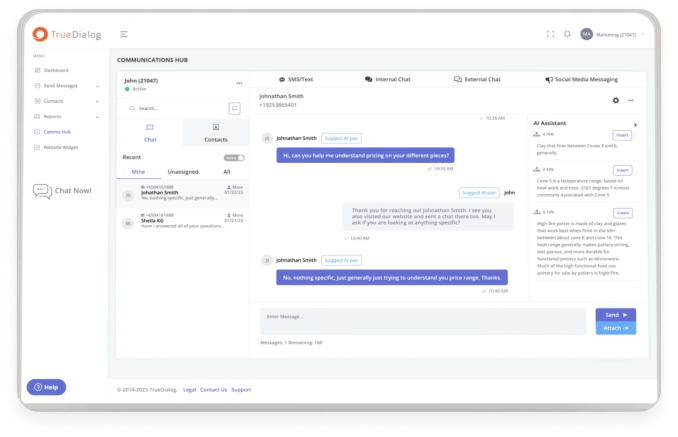Why Are You Spending So Much on Other Platforms?
Once upon a time, marketing included ads in the newspaper and fliers on windshields. Businesses announced promotions through signs on storefront windows, and customer service was a face-to-face dynamic.
Of course, things have shifted since those days. Marketing and communications have continuously evolved, mirroring the means of social interaction. Where email reigned supreme even a few years ago, so too has another approach taken shape: business SMS.
When looking to incorporate SMS into a modern marketing and communications strategy, many organizations wonder where to begin. Building an in-house platform from the ground up can be tempting, but it’s crucial to evaluate the overall cost before taking this approach.
Business SMS for Modern Marketing and Customer Service
Let’s start by saying: email is not dead. It still has its place in B2C interactions and can’t be labeled a true casualty of the modern world. That said, email has become less effective as a primary approach and is why so many organizations are looking to include SMS texting into their communications arsenal.
On average, email has around a 20% open rate. Compare that to 98% of SMS, and you’ll see why businesses are shifting their efforts to business text. Inboxes are crowded, and messages often get buried or missed, particularly at personal addresses. Not only does that mean emails are often unread, but when they are opened, it may take a while.
SMS grabs recipients’ attention, with at least 60% reading text messages within five minutes of delivery. For that reason alone, SMS is a reliable approach to one- and two-way communications with customers.
Not limited to promotional messages, businesses can use SMS for a variety of communications. Modern businesses leverage text messages for notifications, alerts, event invitations, shipping and tracking updates, soliciting feedback, and much more.
Two-way text alleviates pain points in customer service interactions. Automated text trees allow customers to easily select from prompts to direct them to answers to questions or concerns. When it’s time to log an issue or connect with an agent, cases can be initiated via text, saving customers the time otherwise spent listening to hold music. SMS can automatically send messages when certain stages in the buyer journey trigger them, such as payment confirmation, shipment alerts, and upcoming appointments.
Related: Automated Text Message for Business
The True Cost of Building an In-House SMS Solution
Some organizations believe that building an in-house solution is the best way to get started with business SMS. While in-house dev teams know the company’s tech landscape, and it can be a seemingly straightforward process to create your own bulk SMS gateway, there are a few aspects you should consider:
High Development Costs
It’s not easy to build a platform from the ground up. By that, we don’t mean that we have any doubt in the capabilities of your development team, of course. While talented devs may make it look easy, it’s a lot of work. And those dev resources cost you money in both dev time and distractions that keep your team from other projects that need attention and don’t have an easier solution.
Additionally, software developers are in high demand, meaning salaries are not insignificant. The time required to define the project scope and learn how to build a bulk SMS application leads to a significant investment for organizations seeking to bring business texting online.
Companies wouldn’t dream of building an entire email platform, yet many are doing that with SMS thinking it’s somehow simpler, or they’re okay with making do with an SMS platform that doesn’t have all the features required. Internal dev teams are highly unlikely to be able to replicate all of the features a company that specializes in SMS and MMS already created.
Resource Requirements
More than the financial investment, building in-house software solutions requires a lot of time and attention from development teams. Custom-built software is not a set-it-and-forget-it approach. Once it has been created, which can take months to build, developers need to test and monitor its use. More than that, the software requires regular patches and updates to be fully functional and meet the needs of the end user.
As requirements evolve, developers will be required to build new feature sets and perhaps, integrate them with new software applications. While IT teams can easily deploy third-party patches and updates, in-house software pulls developers’ attention away from other projects to write, test, deploy, and monitor these additions. Even with a large development team, most businesses could benefit from having their devs on other projects, including cybersecurity endeavors.
Reinventing the Wheel
All of the above is a worthwhile investment when it comes to functionality that doesn’t exist in the market. Industrious organizations often build in-house solutions to meet needs when they do not have or want a third-party option. SMS is not one of those instances.
Established SMS platforms exist, offering ease of deployment, management, and use without the need to devote ongoing time and energy to create them from scratch. And even those platforms that offer APIs aren’t always easy to use or integrate with the app you’re wanting to connect it with. Why reinvent the wheel when a simple solution is readily available at a fraction of the cost?
Professional SMS platforms are easy to adopt while offering a suite of features that create a powerful user experience. By using a third-party platform, you have a variety of messaging options including 1:1, group, one-to-many messaging, and more.
Benefits of Third-Party Solutions
Building an in-house solution often seems like a worthwhile approach. Organizations perceive a high level of control and flexibility in designing a platform from scratch and often underestimate the financial investment required.
An industry-leading SMS platform built for integrations lowers costs, eliminates lengthy manual processes, and allows for high levels of customization and integration with existing platforms.
Lower Cost
A key aspect many organizations don’t consider when choosing to build their own SMS platform is message cost. While sending personal messages is included in the average cellular plan, the dynamic shifts when sending business SMS. Sending and receiving SMS on behalf of a business is a costly endeavor, causing financial obligations to fluctuate significantly depending on marketing campaigns.
A third-party platform lowers the cost of messaging. With direct carrier connections, not only is delivery more reliable but message costs are lowered – in some cases significantly as high as 80% with TrueDialog. Improving deliverability while lowering SMS marketing costs means a better experience both for customers and internal teams.
Reliability
The delivery of your messages is crucial to your SMS strategy. After all, your marketing and customer service teams will commit time and effort to executing the SMS strategy. If your messages are not reliably delivered or replies are not received, all efforts have gone out the window. Building brand awareness and trust rely on messages being sent, received, and responded to.
An in-house platform requires your developers to be on call, ready to test and fix any issues. A robust third-party platform enables 99.9% uptime. When you integrate with a third-party platform, you have a team available on demand who are experts in troubleshooting and repairing any outages rapidly, even before they affect your company.
Stay Current
Business SMS is continually shifting, with businesses taking new approaches within their MarComm strategy. Rather than waiting to see how the market evolves and responding with prioritized development, a third-party SMS platform keeps you current with zero effort from you or your dev team. New features are added through platform updates, and you are supported in learning how to leverage these changes effectively.
Related: Leveraging CRM With Native Text Messaging: 9 Sales Strategies
Integration
When it comes time to roll out a new workflow or approach, businesses need full buy-in from the employees affected. The best way to ensure your team members embrace the change is to make it easy on them. That’s where integration steps in.
By integrating a business SMS platform into your existing tools, you shorten the learning curve and subsequently lower the potential for resistance from employees. If you’re currently using platforms such as Salesforce, Microsoft Dynamics, Hubspot, or Eloqua, for example, API integration adds functionality to their already familiar interfaces. Moreover, integration makes collaboration amongst teams a breeze.
In-house integration is possible but can be clunky and often requires extensive troubleshooting should something go wrong.
A Top-Class SMS Platform to Fit Your Needs
Building in-house software is an attractive proposition for many organizations. The allure of full control and flexibility is strong, tempting many to start to build from the ground up. It also becomes a lengthy and costly endeavor for many, and the investment doesn’t end once the software is deployed. Ongoing maintenance and updates require staff and capital, adding to the overall cost.
The SMS industry will follow the email software industry, where enterprises will deliberately buy third-party, full-featured software rather than build it themselves. Companies can dramatically reduce the total cost of ownership of such platforms simply by leveraging the expertise of those who have already spent the money developing a great platform.
Ready to learn more about the easiest and most cost-effective way to integrate SMS texting into your communications strategy? Sign up for a free trial with TrueDialog today and see why we are a top-rated industry leader.




